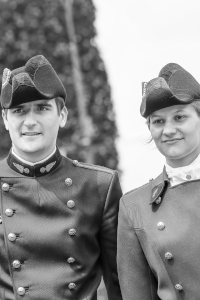IPP Policy Brief n°61
January 2021
Authors: Cécile Bonneau, Pauline Charousset, Julien Grenet and Georgia Thebault
Contact: julien.grenet@ipp.eu
…………………………
 Grandes Écoles: Have they become more socially inclusive since the mid-2000s?
Grandes Écoles: Have they become more socially inclusive since the mid-2000s?
Acknowledgements: This study was carried out in the context of the DEPP-SIES call for research projects entitled “Filières sélectives et mobilité sociale” (Selective programs and social mobility). It received financial support from the Directorate for Evaluation, Forecasting and Performance of the Ministry of National Education, Youth and Sports (MENJS-DEPP) and the Subdirectorate for Information Systems and Statistical Studies of the Ministry of Higher Education, Research and Innovation (MESRI-SIES). The analyses proposed in this policy brief are the sole responsibility of the authors and may not be attributed to the Ministry of National Education, Youth and Sports or the Ministry of Higher Education, Research and Innovation.
Summary: Using a rich new dataset, this policy brief documents the evolution of recruitment for France’s Grandes Écoles since the mid-2000s, according to various characteristics: social composition, geographical origin of students, and gender distribution. Despite the “opening up” measures implemented by some Grandes Écoles in an attempt to diversify their student profiles, their recruitment base has remained very narrow and has hardly changed over the past 15 years. While enrollment has increased significantly in this period, these elite higher education institutions have remained almost entirely out of reach to students from disadvantaged social backgrounds, the share of students from outside the Paris region has not increased, and girls remain underrepresented. This persistent inequality of access to the Grandes Écoles is only partly explained by the differences in academic performance between the groups in question. It has its source upstream in the lack of diversity in the recruitment for preparatory classes and post-baccalaureate schools. The inability of measures implemented since the mid-2000s to initiate a democratization of the Grandes Écoles highlights the limits of the approach that has been favored up to now: a proliferation of local initiatives, with no real national coordination and very little evaluation. This failure invites us to rethink the levers that could be employed to diversify recruitment for selective courses and to encourage greater circulation of elites.
policy brief documents the evolution of recruitment for France’s Grandes Écoles since the mid-2000s, according to various characteristics: social composition, geographical origin of students, and gender distribution. Despite the “opening up” measures implemented by some Grandes Écoles in an attempt to diversify their student profiles, their recruitment base has remained very narrow and has hardly changed over the past 15 years. While enrollment has increased significantly in this period, these elite higher education institutions have remained almost entirely out of reach to students from disadvantaged social backgrounds, the share of students from outside the Paris region has not increased, and girls remain underrepresented. This persistent inequality of access to the Grandes Écoles is only partly explained by the differences in academic performance between the groups in question. It has its source upstream in the lack of diversity in the recruitment for preparatory classes and post-baccalaureate schools. The inability of measures implemented since the mid-2000s to initiate a democratization of the Grandes Écoles highlights the limits of the approach that has been favored up to now: a proliferation of local initiatives, with no real national coordination and very little evaluation. This failure invites us to rethink the levers that could be employed to diversify recruitment for selective courses and to encourage greater circulation of elites.
Key points:
- The recruitment base of the Grandes Écoles is very narrow: Two-thirds of their students come from a very privileged social background, one-third had their secondary education in the Paris region (40% in the most selective Grandes Écoles), and boys make up nearly 60% of their students.
- The probability of attending a Grande École varies considerably from one high school (lycée) to another: half of the general and technological high schools provide only 13% of the students at the Grandes Écoles, while at the other end of the spectrum, 17% of the general and technological high schools alone provide half of their students.
- The differences in admission rates to the Grandes Écoles according to social background, gender, or geographic origin are of the same order of magnitude as the inequalities in access to the educational programs that prepare students for them: preparatory classes and post-bac schools.
- Differences in academic performance explain less than half of the social inequalities in access to preparatory classes and Grandes Écoles and less than 20% of the geographic inequalities in access. A fortiori, academic performance does not in any way explain the under-representation of girls in the Grandes Écoles.
- Despite the “opening up” measures implemented by certain Grandes Écoles, recruitment to these institutions has remained virtually unchanged since the mid-2000s.
Ce message est également disponible en :  French
French


